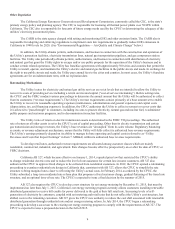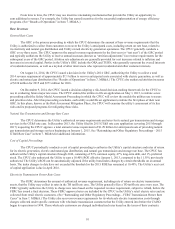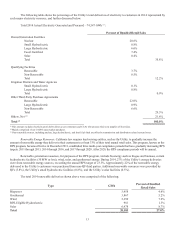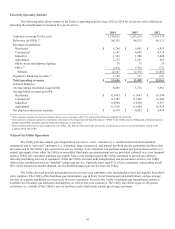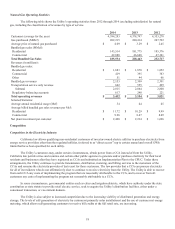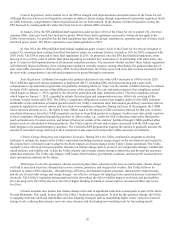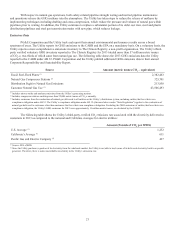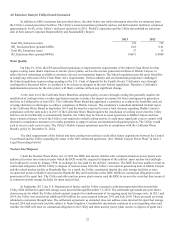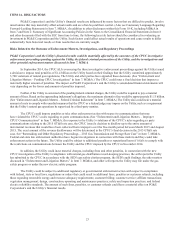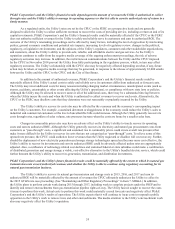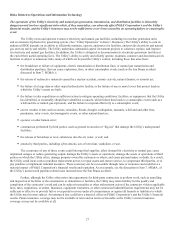PG&E 2014 Annual Report Download - page 27
Download and view the complete annual report
Please find page 27 of the 2014 PG&E annual report below. You can navigate through the pages in the report by either clicking on the pages listed below, or by using the keyword search tool below to find specific information within the annual report.19
Competition in the Natural Gas Industry
The Utility primarily competes with other natural gas pipeline companies for customers transporting natural gas into
the southern California market on the basis of transportation rates, access to competitively priced supplies of natural gas, and
the quality and reliability of transportation services. The Utility also competes for storage services with other third-party storage
providers, primarily in northern California.
Environmental Regulation
The Utility’s operations are subject to extensive federal, state and local laws and requirements relating to the protection
of the environment and the safety and health of the Utility’s personnel and the public. These laws and requirements relate to a
broad range of activities, including the remediation of hazardous and radioactive substances; the discharge of pollutants into the
air, water, and soil; the reporting and reduction of carbon monoxide (CO2) and other GHG emissions; the transportation, handling,
storage and disposal of spent nuclear fuel; and the environmental impacts of land use, including endangered species and habitat
protection. The penalties for violation of these laws and requirements can be severe and may include significant fines, damages,
and criminal or civil sanctions. These laws and requirements also may require the Utility, under certain circumstances, to interrupt
or curtail operations. (See Item 1A. Risk Factors.) Generally, the Utility has recovered most of the costs of complying with
environmental laws and regulations in the Utility’s rates, subject to reasonableness review. Environmental costs associated with
the clean-up of most sites that contain hazardous substances are subject to a special ratemaking mechanism described in Note 14:
Contingencies—Environmental Remediation Contingencies, of the Notes to the Consolidated Financial Statements in Item 8.
Hazardous Waste Compliance and Remediation
The Utility’s facilities are subject to the requirements of the federal Resource Conservation and Recovery Act and the
Comprehensive Environmental Response, Compensation and Liability Act of 1980 as amended (CERCLA). The Utility is also
subject to the regulations adopted by the EPA, the federal agency responsible for implementing the federal environmental laws.
The Utility also must comply with environmental laws and regulations adopted by the State of California and various state and
local agencies. These federal and state laws impose strict liability for the release of a hazardous substance on the (1) owner or
operator of the site where the release occurred, (2) on companies that disposed of, or arranged for the disposal of, the hazardous
substances, and (3) in some cases, their corporate successors. Under CERCLA these persons (known as “potentially responsible
parties”) may be jointly and severally liable for the costs of cleaning up the hazardous substances, paying for the harm caused to
natural resources, and paying for the costs of required health studies.
The Utility has a comprehensive program in place to comply with these federal, state, and local laws and regulations.
Under federal and California laws, the Utility may be responsible for remediation of hazardous substances even if it did not
deposit those substances on the site. The Utility’s remediation activities are overseen by the California Department of Toxic
Substances Control, several California regional water quality control boards, and various other federal, state, and local agencies.
The Utility has incurred significant environmental remediation liabilities associated with former manufactured gas plant sites,
power plant sites, gas gathering sites, sites where natural gas compressor stations are located, and sites used by the Utility for the
storage, recycling, or disposal of potentially hazardous substances. Groundwater at the Utility’s Hinkley and Topock natural gas
compressor stations contains hexavalent chromium as a result of the Utility’s past operating practices. The Utility is responsible for
remediating this groundwater contamination and for abating the effects of the contamination on the environment.
For more information about environmental remediation liabilities, see Note 14: Commitments and Contingencies−
Environmental Remediation Contingencies, of the Notes to the Consolidated Financial Statements in Item 8.
Air Quality and Climate Change
The Utility’s electricity generation plants, natural gas pipeline operations, fleet, and fuel storage tanks are subject to
numerous air pollution control laws, including the federal Clean Air Act, as well as state and local statutes. These laws and
regulations cover, among other pollutants, those contributing to the formation of ground-level ozone, CO2, sulfur dioxide (SO2),
mono-nitrogen oxide (NOx), particulate matter, and other GHG emissions.
In December 2009, the EPA concluded that GHG emissions contribute to climate change and issued a finding that GHG
emissions cause or contribute to air pollution that endangers public health and welfare. In May 2014, the United States released its
third National Climate Assessment, which stated that the global climate is changing and that impacts related to climate change are
already evident in many sectors and are expected to become increasingly disruptive across the nation throughout this century and
beyond.


